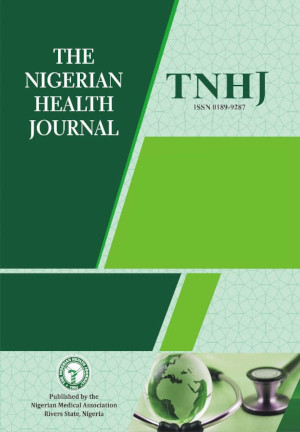Isolation and Identification of Fungi spp Associated with Bread Spoilage in Lapai, Niger State
DOI:
https://doi.org/10.71637/tnhj.v25i1.991Keywords:
Bread Spoilage, One Health, Fungi spp, Antifungal resistanceAbstract
Background: Bread is a widely consumed perishable food that undergoes physical, chemical, sensory, and microbiological changes during storage, leading to spoilage. Contaminated bread can cause intestinal disorders, disease outbreaks, and antifungal resistance. This study investigated fungal contamination in bread sold in Lapai, Niger State, Nigeria, and assessed its proximate and physicochemical properties.
Methods: Bread samples were collected from five street-vended locations in Lapai and analyzed in the microbiology laboratory. Samples were inoculated on Sabouraud Dextrose Agar (SDA) with chloramphenicol to inhibit bacterial growth.
Results: A total of 15 bread samples were analyzed, with fungal isolates including Aspergillus spp. (50%), Mucor spp. (18.75%), Fusarium spp. (6.25%), Penicillium spp. (12.5%), and Rhizopus spp. (12.5%).
Conclusion: Mold spoilage reduces bread shelf life, leading to economic losses in the bakery industry. Poor hygiene and post-production contamination contribute to fungal growth and antifungal resistance. Implementing strict hygiene practices, heat treatments, and proper packaging can help mitigate bread spoilage and associated health risks.
Downloads
References
1. Adeparusi EO. Effect of processing nutrient and anti-nutrients of lima bean (Phaeolus lanatus) flour. J. Narhung. 2001; 45(2), 94-96.
2. Ekpeyang TE. Chemical composition and amino acid content of African breadfruit Trculia Africana Decne . J. Food Chem. 2005; 2(17), 59-64.
3. Arini LDD. Faktor-Faktor Penyebab dan Karakteristik Makanan Kadaluarsa Yang Berdampak Buruk pada Kesehatan Masyarakat. JITIPARI (Jurnal Ilmiah Teknologi Dan Industry Pangan UNISRI). 2017; 2(1), 15–24
4. Broto W. Status Cemaran Dan Upaya Pengendalian Aflatoksin Pada Komoditas Serealia Dan Kacang. Jurnal Litbang Pertanian. 2018; 37(2), 81-90.
5. Lawal RO and Bassir O. The nutrient composition of the Afon Diet Nigerian Cooked Testa-free seed prepared from the fruit of Treculia Africana. J. Food Chem. 2007; 4(23), 308.
6. Nwaiwu MY, Efiuvwevewere BO and Princewill TJ. Biodeterioration of African breadfruit (Treculia africana) in South eastern Nigeria and its control. J. Tropical Sci. 2000; 1(35), 22-29.
7. Leobel FC. The Complex Origin of Breadfruit Trees of plant. J. Botany. 2002; 12(4), 760-766.
8. Fiorentini C, Pianetti A, Baffone W, Fabbri A. Occurrence, diversity, and pathogenicity of halophilic Vibrio spp. and non-O1 Vibrio cholerae from estuarine waters along the Italian Adriatic coast. Appl Environ Microbiol. 1999; 65, 2748-2753.
9. Balick M. and Cox P. Plants, people and culture. J. Sci. Ethnobot. 1999; 15(3), 85-88.
10. Hocking AD. Mold and Yeast Associated with Foods of Reduced Water Activity. Ecological Interactions. In: Seow, C. C (Ed), Food Preservation by Moisture Control. Elsevier. 2008; 57–72.
11. Ejidike BN. Dietary protein requirements of the African land snail (Archachantina marginata). J. Appl.Tropical Agricult. 2001; 1(6), 111-115.
12. Chigbu LN, Iroegbu CU. Vibrio species from diarrhoeal stools and water environment in Cross River State, Nigeria. Int J Environ Health Res. 2000; 10, 219-228.
13. Ejiofor MA, Obiajulu OR and Okafor JC. Diversifying utilities of African breadfruit as food and feed. J. Inter. Tree Crops. 2008; 1(51), 25-134.
14. Basier O and Lawal RO. Changes in the major nutrient of the seeds of Treculia Africana during dietary preparation. J. Plant Food. 2006; 1(6), 249.
15. Edet EE, Eke OU and Ifon EI. Chemical evaluation of nutritive value of seed of African Breadfruit. J. Food Chem. 2002; 2(17), 41-47.
16. Mizana KD. Identifikasi Pertumbuhan Jamur Aspergillus Sppada Roti Tawar yang Dijual di Kota Padang Berdasarkan Suhu dan Lama Penyimpanan. Jurna Kesehatan Andalas. 2016; 5(2), 355–360.
17. Lestari AD. Identifikasi Jamur Pada Roti Yang Dijual Di Kota Langsa Berdasarkan Lama Penyimpanan. Journal Jeumpa. 2019; 6(2), 245-256.
18. Adeparusi EO. Effect of processing nutrient and anti-nutrients of lima bean (Phaeolus lanatus) flour. J. Narhung. 2001; 45(2), 94-96.
19. Dharmaputra OS. Kualitas Fisik, Populasi Aspergillus flavus, dan Kandungan Aflatoksin B1 pada Biji Kacang Tanah Mentah. Jurnal Fitopatologi Indonesia. 2013; 9(4), 99-106
20. Gouse B, Ali Ismail A, Zafer S and Omar B. Assessment of Bacteria and Fungi in Air from College of Applied Medical Sciences (Male) at AD-Dawadmi, Saudi Arabia. Int. Res. J. Biol. Sci. 2015; 4(9), 48-53.
21. Hasanah U. Mengenal Aspergillosis, Infeksi Jamur Genus Aspergillus. Jurna Keluarga Seha Sejahtera. 2017;15(2), 76–86.
Published
Versions
- 2025-06-01 (2)
- 2025-04-01 (1)
Issue
Section
License
Copyright (c) 2025 Aishat Rabiu Sani, Testimony Mariam Hamza, I. M. Legbo, F. I. Jubril, A Ibrahim, Abdullahi Mohammed, Ayuba Sunday Buru

This work is licensed under a Creative Commons Attribution-NonCommercial-ShareAlike 4.0 International License.
The Journal is owned, published and copyrighted by the Nigerian Medical Association, River state Branch. The copyright of papers published are vested in the journal and the publisher. In line with our open access policy and the Creative Commons Attribution License policy authors are allowed to share their work with an acknowledgement of the work's authorship and initial publication in this journal.
This is an open access journal which means that all content is freely available without charge to the user or his/her institution. Users are allowed to read, download, copy, distribute, print, search, or link to the full texts of the articles in this journal without asking prior permission from the publisher or the author.
The use of general descriptive names, trade names, trademarks, and so forth in this publication, even if not specifically identified, does not imply that these names are not protected by the relevant laws and regulations. While the advice and information in this journal are believed to be true and accurate on the date of its going to press, neither the authors, the editors, nor the publisher can accept any legal responsibility for any errors or omissions that may be made. The publisher makes no warranty, express or implied, with respect to the material contained herein.
TNHJ also supports open access archiving of articles published in the journal after three months of publication. Authors are permitted and encouraged to post their work online (e.g, in institutional repositories or on their website) within the stated period, as it can lead to productive exchanges, as well as earlier and greater citation of published work (See The Effect of Open Access). All requests for permission for open access archiving outside this period should be sent to the editor via email to editor@tnhjph.com.












